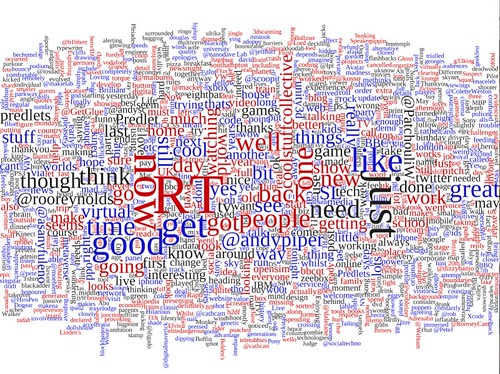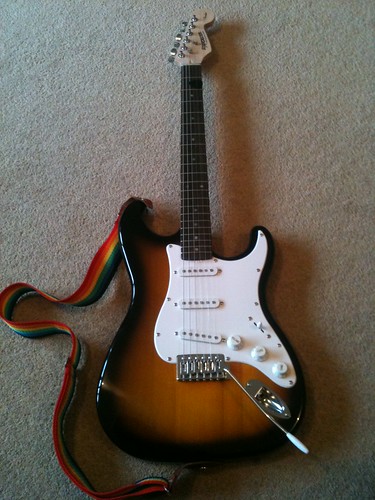Last night many of us watched on Ustream as Sony unveiled the PS4. As I tweeted at the time it was great to see Ustream in such a high profile event as we streamed a Second Life and real world interview at Wimbledon back in 2007. Just a few of us with portable cameras and a willingness to try something different.
Sony had a pretty impressive stage set up. There was a very large main screen, but they went for a CAVE type approach and around the screen and the side walls formed part of the experience.It was a bit like Microsoft’s Illumiroom ?
There was a massive influx of tweets when the first person on said “over the next 2 hours we will…..” and shouts of get on with it please!
Anyway, they did get on with it. The PS4 is pretty much a ramped up general purpose computer again. It has significant extra memory and additional processors to do some of the extra tasks. One of the things they mentioned was that it would be able to download patches and updates in the background. i.e. unlike the PS3 which sits and downloads patches not allowing you do anything else. Of course this really should be what they do. As part of this they announced being able to play games whilst they were downloading. So this is down to the design process to give you the bits you need at the start, not just a loading screen game as we used to see in the 8 bit days.
The new controller was unveiled, it is pretty much the old controller with a touch pad. A significant feature was a big light on the front. The said this was to help identify one another’s controller more easily. That was not really true as it was then announced a dual camera sensor would ship with the unit and it would be able to see the controllers. i.e. they stuck the glowing PS Move lights into the controllers 🙂 We will have to see what benefit that gives.
Sharing and connecting featured heavily. Being able to access content anywhere and targeted content. “A dynamic preference driven path through the world of content” apparently! The PS Vita was often mentioned too as the perfect way to enjoy streamed content when the main TV could not be used. Remote play.
Then there was cloud streaming. It had to feature as Sony had bought Gaiki It is a core of the social experience too it would seem. So if something is on the PS Store you can play it straight away, no need to download (or pay) making any game have a free trial period. As network speeds increase this makes a great deal of sense. Of course it then does make you wonder why you need a massively powerful console device if rendering is done remotely. However the best of both worlds can’t hurt can it.
The PS4 controller now gets a share button. A physical share button rather then the web page ones of Facebook and alike. This lets you share whatever you are doing to whoever in all the various permutations. They have put a dedicated video compression processor on board that basically encodes the last n minutes (I think n is 15) of whatever you are doing. You hit share and it throws the video to the world. This is to cut out all editing apparently. I hope it does not remove replay options in games as being able to recreate a moment from data and view it from anywhere is still great fun. Everyone replaying the same in game view of the same thing may get a little… samey.
Other than the PS Vita all the other second screens got a mention. So we will have to see how designers use these.
**Updated I almost forgot (it was a long show) they extended the social aspect and the remote play so that you can hand over the reigns of a game to someone somewhere else in the world. It is a bit like when one of the predlets ask me to do a bit of a level for them and hand me a controller. Whether many gamers want to hand over control is another matter. I am reminded of a patent idea @martinjgale and I did years ago at the old company. It was one that detected your level of inability to complete a level, or frustration and patched in remotely a guide or helper to get you past your moments of despair and enjoy the rest of the game. It was a great idea but somehow it didn’t get through the review process as they regard it as silly. Well….. 🙂
The main UI looked very Xbox 360, with the current trend for huge great video icons laid out in Mondrial style patterns, some animated. Primarily so that our clumsy touch interfaces can target them. Still it looked nice.
Then we were treated to a whole host of games, probably in game footage, but where cut scenes end and game begins is not alway clear. We did though get straight into first person shooting and then first person driving. Great genres, now shinier and smoother. Not a massive leap in game design though.
So I am sure the PS4 will be great, I am sure when they finally release it I will have to add to the console collection. The test will be if it has great content that is worth all this sharing. That of course is down to the games industry. They have a new box ready to do massive triple A titles. As long as they don’t forget the innovation that brings us awesome experiences like Minecraft! which the talking heads video seems to indicate 🙂
Here are the games though





